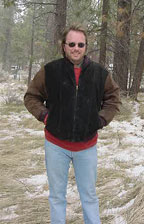 Recording real wind sounds and thunderstorms are some of the most difficult field recordings to capture. I can’t tell you how many times I’ve gone on wild goose chases in the middle of storms trying to get the ultimate field recording. Big Bear, California was one place I traveled to a half dozen times alone. I always felt very tricked by Mother Nature. As soon as I would finally scout the perfect location, conditions would change and the moment was lost.
Recording real wind sounds and thunderstorms are some of the most difficult field recordings to capture. I can’t tell you how many times I’ve gone on wild goose chases in the middle of storms trying to get the ultimate field recording. Big Bear, California was one place I traveled to a half dozen times alone. I always felt very tricked by Mother Nature. As soon as I would finally scout the perfect location, conditions would change and the moment was lost.
THE GEAR
For field recording I use a quality stereo microphone (around $1,000) and portable DAT recorder. I’ve been doing field recordings for a long time now and there might be updated gear like portable CD recorders you can use now. But I’m used to the DAT recorders and like the sound quality. I prefer Shure and Tascam products for my field recording.
THUNDER
By the time you hear the thunder, it’s probably too late to get your recording. Since thunder is usually accompanied by rain, the optimum recording would be as a storm is approaching you. Here you can get the thunder sound without the interfering rain sounds. Getting wet is a major issue. This may not seem like much as you’re sitting in front of your computer reading this, but when you’re out in the middle of the yuck it is most definately a problem.
Wrap your recording gear in plastic, and then cover the plastic with a soft material like a blanket. Yes, your blanket is going to get soaked. The plastic is going to make sound as the rain hits it, so using a soft cloth will lessen the water sounds. I’ve tried recording before through car windows, but there’s too much interference from rain hitting the car. I would suggest recording out the trunk, with a blanket over the trunk for a thunderstorm. It’s not pretty, but I did capture an excellent thunderstorm in Southern California using this technique, until the rain got too heavy.
If you are doing historical archive recording then what you get is what you get. But if you are doing nature sound recordings for multimedia, keep in mind your finished product should be what the listener expects the sound to be. Real wind is not pretty – most people want to hear that sweet whistling sound. Give them what they expect, that’s the challenge.
Alternately you can improvise a “lean-to” for your gear. With thunder recordings one problem is your microphone needs to be up a bit to capture the thunder. This bares the microphone to the elements. Create a lean to with a blanket, your gear covered in plastic and find a natural location that will shield from the wind. You’ll need those low end frequencies for a good thunder recording and won’t be able to roll off those low wind howls later in mastering.
WIND
I never realized how different real wind is to capture for recording until I tried to do it. We are used to hearing wind with our ears feeling the pound of the low rumble. On an audio recording this comes across as distortion, not a pleasant sound like it is to our ears. The trick in wind recording is not to actually record the wind, but to record the wind interacting with another surface.
Good locations for wind recordings can be corners of buildings or cracks in walls. This will give you the whistle and howl timbres that most people associate with the sound of wind. One great place for wind recording is the top of a ski slope next to a utility shack. You’ll get some great howling at that location.
Shield yourself from the actual wind so you can get decent levels for your recording. If you try to actually record directly into the wind, you’ll get such a decibel rush that your low levels won’t have the levels you need in mastering.
Hope that helps. Nobody said field recording would be pretty.
Conrad Askland is an audio producer and field recording engineer.